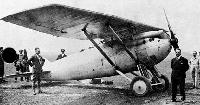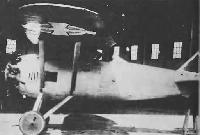
Варианты
- Dewoitine - D.1 / D.9 - 1922 - Франция
- Ansaldo - A-115 / A-120 Ady - 1925 - Италия
- Ansaldo - AC.3 / AC.4 - 1926 - Италия
Dewoitine D.1 и D.9
Первым самолетом, спроектированным французским конструктором Эмилем Девуатином (также иногда Девотин) после основания в октябре 1920 года собственной компании, стал одноместный истребитель-моноплан с высокорасположенным крылом D.1. Самолет создавался под требования французской авиационной технической службы (Service Technique de l'Aeronautique) от 1921 года, однако вследствие задержек первый прототип D.1.01 поднялся в воздух только 18 ноября 1922 года. Он имел металлический фюзеляж овального поперечного сечения и металлическое подкосное крыло первоначально с обшивкой из дюралевых листов (затем с полотняной обшивкой), был оснащен двигателем Hispano-Suiza 8Fb мощностью 300 л. с. (224 кВт) с двумя радиаторами Lamblin внизу носовой части фюзеляжа. Но обзор вперед из кабины был затруднен, и компания разработала усовершенствованный вариант D.1 bis, на котором отказались от хорошей в силовом отношении системы подкосов (они и ограничивали обзор летчика), укрепив крыло на центральном пилоне и применив традиционную систему подкосов, благодаря чему самолет превратился в моноплан-парасоль. Работы по переоборудованию D.1.01 в D.1 bis были завершены в августе 1923 года, причем к тому времени компания уже построила в базовом варианте три из 10 предсерийных машин: две из них были потеряны в авариях, а третий самолет переоборудовали по стандарту D.1 bis. Следующие пять машин строились уже изначально как D.1 bis - по одному самолету предназначались для Чехословакии, Италии и Японии, а два - для Швейцарии. Однако эксплуатанты продолжали жаловаться на плохой обзор из кабины, в результате чего Девуатин разработал модификацию D.1 ter, которая отличалась еще и крылом уменьшенного размаха, но с увеличенной хордой, а радиаторы крепились на передних опорах неубирающегося шасси. По этому варианту достраивались два самолета для Швейцарии и последние две машины из предсерийной партии по французскому заказу.
После демонстрационных полетов D.1 в ряде стран (пилот Марсель Доре) компания получила на самолет дополнительные заказы. Югославия согласилась приобрести 60 машин (впоследствии заказ уменьшен до 44), а Италия отдала ему предпочтение перед Dornier Do Н Falke, причем компания "Ansaldo" приобрела лицензию на выпуск D.1 ter под обозначением A.C.2 (итальянские ВВС получили 112 таких самолетов, находившихся в строевых частях до 1929 года). Французские ВВС, несмотря на заказ на 20 таких истребителей, в конечном итоге отказались принимать их на вооружение и больше заказов не размещали. Но D.1 ter был принят на вооружение авиации ВМС Франции - в ноябре 1923 года был подписан контракт на 44 самолета D.1 ter, постройка которых поручалась фирме SECM ("Societe d'Emboutissage et de Constructions Mecaniques"). Первая из этих машин поднялась в воздух 18 января 1925 года, в дальнейшем 15 самолетов поступили на вооружение эскадрильи 7С1, приписанной к авианосцу "Беарн".
Последовавший затем одноместный истребитель D.9 в целом конструктивно был похож на D.1, но размах крыла был увеличен на 1,3 м. Данный самолет создавался в соответствии с требованиями от 1923 года на самолет в категории C.1 (одноместный истребитель), а его прототип D.9.01, оснащенный звездообразным двигателем Gnome-Rhone (Bristol) Jupiter, совершил первый полет в июне 1924 года. Однако французские ВВС не приняли и этот самолет, но компании удалось набрать ряд экспортных заказов - даже несмотря на то, что головная машина была потеряна в результате аварии в октябре 1925 года. В конечном итоге Бельгия приобрела одну машину, Югославия - шесть самолетов, а швейцарская компания EKW собрала три самолета из комплектов, полученных от компании Девуатина. Но самым важным заказчиком стали итальянские ВВС, разместившие заказ на 150 самолетов - они строились по лицензии итальянской "Ansaldo" под обозначением A.C.3.
ТАКТИКО-ТЕХНИЧЕСКИЕ ХАРАКТЕРИСТИКИ
Dewoitine D.1 ter
Тип: одноместный истребитель
Силовая установка: один V-образный ПД Hispano-Suiza 8Fb мощностью 300 л.с. (224 кВт)
Летные характеристики: максимальная скорость на высоте 2000 м - 250 км/ч; начальная скороподъемность 450 м/мин; практический потолок 8000 м; дальность 400 км
Масса: пустого снаряженного 820 кг; максимальная взлетная 1240 кг
Размеры: размах крыла 11,50 м; длина 7,50 м; высота 2,75 м; площадь крыла 20,00 м2
Вооружение: два 7,7-мм стреляющих вперед фиксированных пулемета Vickers вверху носовой части фюзеляжа
Описание:
- Dewoitine D.1 и D.9
- Flight, June 1924
THE THIRD INTERNATIONAL AERO SHOW AT PRAGUE - Flight, December 1924
The Paris Aero Show 1924
Фотографии
-
Мировая Авиация 43
18 ноября 1922г.: первый полет Dewoitine D.1 с крылом типа "парасоль", впоследствии он использовался на авианосце "Беарн" и выпускался по лицензии в Италии.
-
Air Enthusiast 1971-11 / Fighter A to Z (6)
The Ansaldo AC.2 fighter, a licence-built Dewoitine D.1.
-
Мировая Авиация 108
D.1 конструкции Девуатина представлял собой моноплан-парасоль.
-
Flight 1924-06 / Flight
THE DEWOITINE MONOPLANE, 300 H.P. HISPANO-SUIZA ENGINE: The machine actually exhibited at Prague is fitted with the new type Lamblin radiators mounted on the struts of the undercarriage.
-
Jane's All the World Aircraft 1980 / Encyclopedia of Aviation - Aircraft A-Z - v3
One of two Swiss Dewoitine D.1s.
-
Jane's All the World Aircraft 1980 / Encyclopedia of Aviation - Aircraft A-Z - v3
French Navy Dewoitine D.1s.
-
Flight 1924-12 / Flight
ON THE DEWOITINE STAND: On the left is seen a D1C1, which had to land in a thick fog and turned over without sustaining other damage than a bent rudder and one or two punctures in the wing covering. In the background is the large commercial monoplane, while on the right is a single-seater fighter similar to the D1C1 except for the cabane, which is slightly different in construction.
Другие самолёты на фотографии: Dewoitine D.14 - Франция - 1924
-
Flight 1924-12 / Flight
Two more Dewoitines: In the foreground the light monoplane with 6-cylinder Vaslin engine, and behind it the D.1 single-seater fighter all-metal monoplane with 300 h.p. Hispano-Suiza.
Другие самолёты на фотографии: Dewoitine D.7 - Франция - 1923
-
Flight 1928-02 / Flight
SEVEN-AND-A-QUARTER MILES HIGH: Comm. Donati, the Italian pilot, who recently attained an altitude of 11,852 m. (38,886 ft.) on an Ansaldo-Dewoitine monoplane fitted with an Alfa-Romeo "Jupiter" engine. He is seen wearing his special flying kit and "Salvator" parachute.
-
Jane's All the World Aircraft 1980 / Encyclopedia of Aviation - Aircraft A-Z - v3
Swiss Dewoitine D.9.
-
Jane's All the World Aircraft 1980 / Encyclopedia of Aviation - Aircraft A-Z - v3
Yugoslav Dewoitine D.9.
-
Air Enthusiast 1971-11 / Fighter A to Z (6)
The Ansaldo A.C.2
- Фотографии











